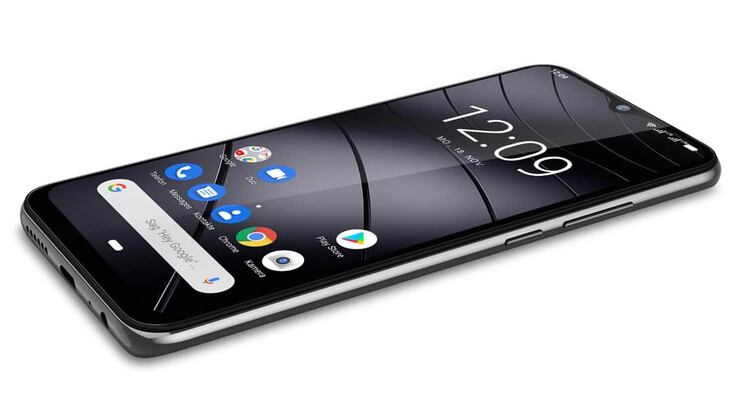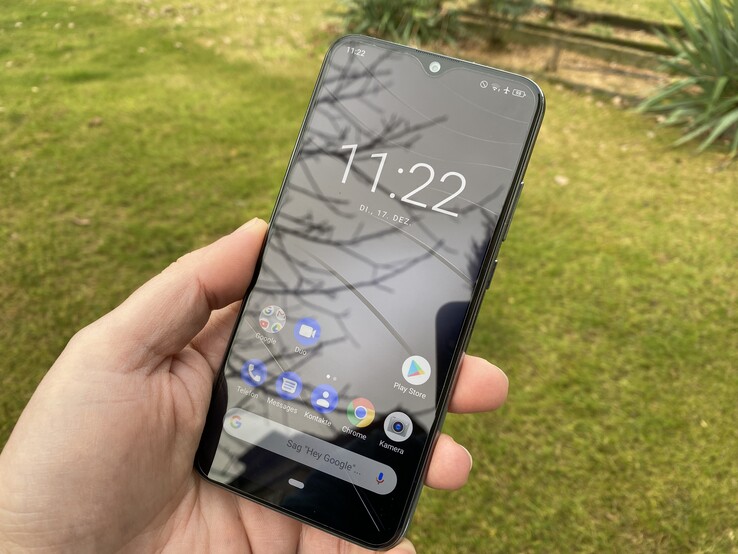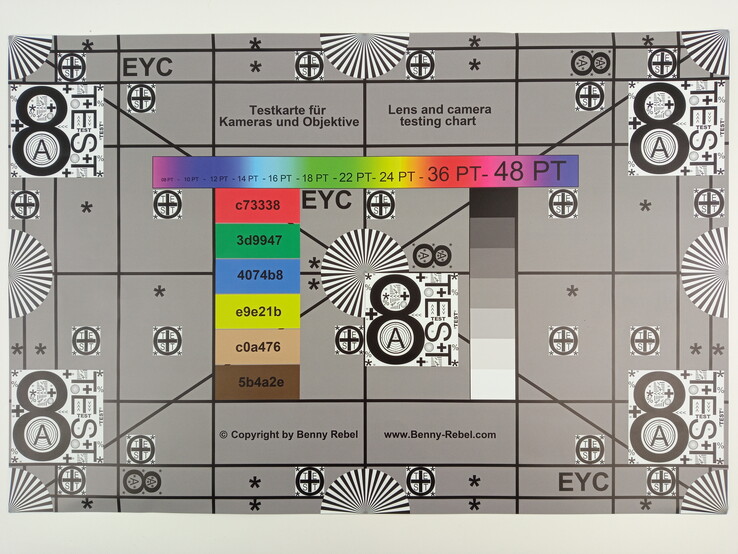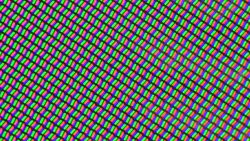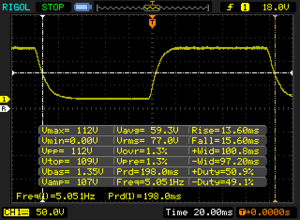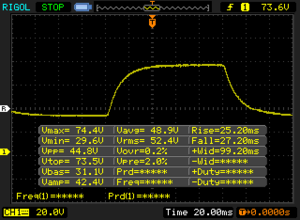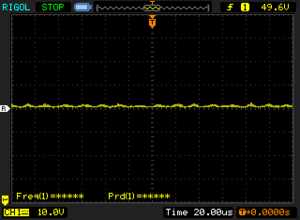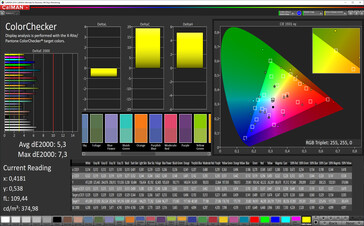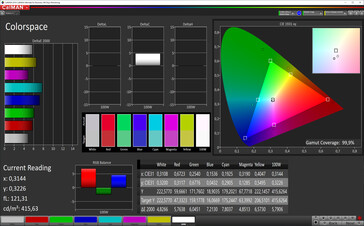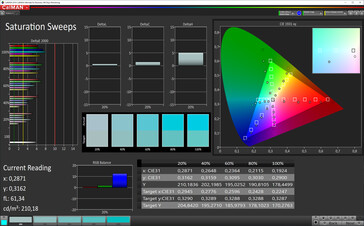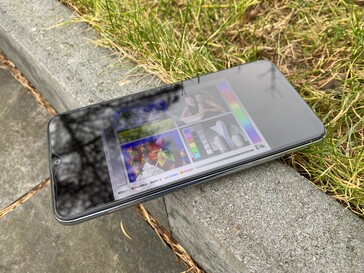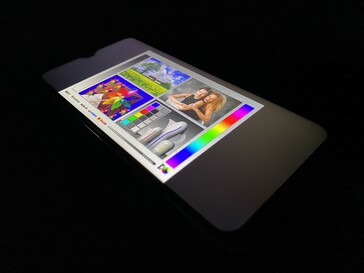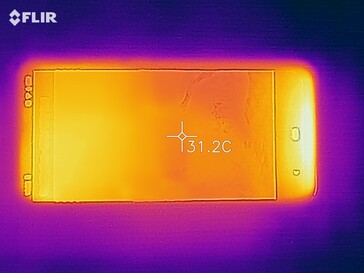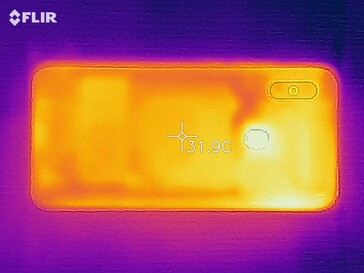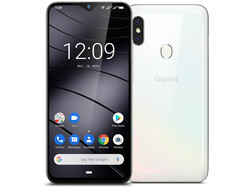Gigaset GS290 Review - Good smartphone with small weaknesses
Comparison Devices
Bewertung | Rating Version | Datum | Modell | Gewicht | Laufwerk | Groesse | Aufloesung | Preis ab |
|---|---|---|---|---|---|---|---|---|
| 75.5 % v7 (old) | v7 (old) | 12 / 2019 | Gigaset GS290 Helio P23 MT6763V, Mali-G71 MP2 | 190 g | 64 GB eMMC Flash | 6.30" | 2340x1080 | |
| 80.5 % v6 (old) | v6 (old) | 07 / 2019 | Wiko View 3 Helio P22 MT6762, PowerVR GE8320 | 178 g | 64 GB eMMC Flash | 6.26" | 1520x720 | |
| 79.1 % v7 (old) | v7 (old) | 05 / 2019 | Samsung Galaxy A40 Exynos 7904, Mali-G71 MP2 | 140 g | 64 GB eMMC Flash | 5.90" | 2340x1080 | |
| 78.4 % v7 (old) | v7 (old) | 09 / 2019 | Xiaomi Mi A3 SD 665, Adreno 610 | 173.8 g | 64 GB UFS 2.1 Flash | 6.09" | 1560x720 |
Case, Equipment and Communication
The Gigaset GS290 is made of a glass-plastic mixture and is available in black and white. The smartphone, which is manufactured in Germany, is cleanly finished and already has a bubble-free display protection film applied ex works. The battery is permanently installed, there is no IP certification.
The USB 2.0 port has the current Type C design and supports OTG. It is also equipped with an audio jack, a radio receiver and a hybrid SIM slot. The latter either accepts two nano-SIM cards or instead of the second SIM a microSD card, which however does not support exFAT and to which only media can be swapped. Another practical feature is the possibility of charging the smartphone wirelessly.
As operating system Android 9.0 Pie is used, which is equipped with the still quite current security patches from October 5th, 2019 at the time of testing. Gigaset plans to release security updates quarterly, and Android 10 is also scheduled to be rolled out for the GS290 next year. Unfortunately, there is no DRM certification for the GS290, so content protected accordingly can only be consumed in SD.
The Gigaset smartphone has a regionally limited frequency range, but there should be no restrictions within Europe. The particularly low radiation levels are a positive feature here. NFC, dual-band WLAN and Bluetooth 5.0 are also on board.
| Networking | |
| iperf3 transmit AX12 | |
| Samsung Galaxy A40 | |
| Xiaomi Mi A3 | |
| Gigaset GS290 | |
| Wiko View 3 | |
| iperf3 receive AX12 | |
| Samsung Galaxy A40 | |
| Xiaomi Mi A3 | |
| Gigaset GS290 | |
| Wiko View 3 | |
Cameras - Mediocre dual camera in the GS290
The Gigaset GS290's front camera has a resolution of 16 MP and, with enough light, allows for a good deal of selfies. Videos are recorded in Full HD at best.
The dual camera on the back consists of a 16 MP and a 2 MP lens, whereby the latter only collects depth information for the portrait function. We don't like the GS290's photos very much because the autofocus doesn't always sit properly and despite the high resolution, the level of detail remains at a modest level. However, we like the camera app and it offers both a professional and a night mode. The main camera records videos in Full HD (30 FPS).
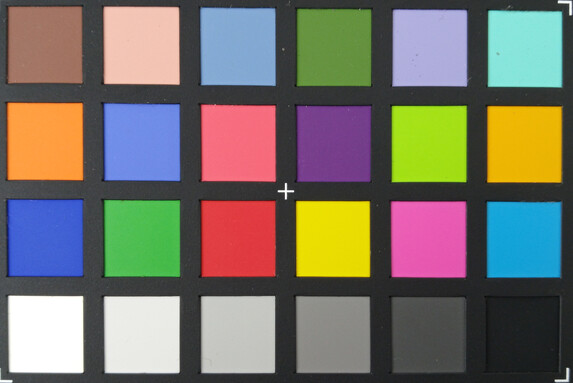

Display - Gigaset phone with bright IPS panel
The GS290 has a 6.3-inch (16 cm) IPS display that offers high pixel density and good luminosity. Limitations must be feared on very sunny days. Unfortunately, the APL50 measurement shows weaker values. The brightness is 351 cd/m² in the center of the image and the black value of 0.3 cd/m² is also still good, but about 50 percent higher than in the full area measurement, so that the realistic contrast is 1,170:1.
The color representation is quite good and can be further adjusted to one's own needs in the settings. A night mode is also available.
| |||||||||||||||||||||||||
Brightness Distribution: 88 %
Center on Battery: 465 cd/m²
Contrast: 2325:1 (Black: 0.2 cd/m²)
ΔE Color 5.3 | 0.5-29.43 Ø4.83
ΔE Greyscale 4.2 | 0.09-98 Ø5.1
99.9% sRGB (Calman 2D)
Gamma: 2.09
| Gigaset GS290 IPS, 2340x1080, 6.3" | Wiko View 3 IPS, 1520x720, 6.3" | Samsung Galaxy A40 Super AMOLED, 2340x1080, 5.9" | Xiaomi Mi A3 AMOLED, 1560x720, 6.1" | |
|---|---|---|---|---|
| Response Times | 24% | 77% | 82% | |
| Response Time Grey 50% / Grey 80% * | 52.4 ? | 49.2 ? 6% | 10 ? 81% | 8 ? 85% |
| Response Time Black / White * | 29.2 ? | 16.8 ? 42% | 8 ? 73% | 6 ? 79% |
| PWM Frequency | 245 | 219 | ||
| Screen | 4% | -24% | -26% | |
| Brightness middle | 465 | 574 23% | 358 -23% | 348 -25% |
| Brightness | 460 | 552 20% | 370 -20% | 355 -23% |
| Brightness Distribution | 88 | 91 3% | 94 7% | 91 3% |
| Black Level * | 0.2 | 0.19 5% | ||
| Contrast | 2325 | 3021 30% | ||
| Colorchecker dE 2000 * | 5.3 | 5.5 -4% | 7.4 -40% | 5.86 -11% |
| Colorchecker dE 2000 max. * | 7.3 | 9.5 -30% | 12.5 -71% | 15.6 -114% |
| Greyscale dE 2000 * | 4.2 | 5 -19% | 4 5% | 3.6 14% |
| Gamma | 2.09 105% | 2.1 105% | 2.084 106% | 2.232 99% |
| CCT | 6558 99% | 7610 85% | 7078 92% | 7051 92% |
| Total Average (Program / Settings) | 14% /
8% | 27% /
2% | 28% /
1% |
* ... smaller is better
Display Response Times
| ↔ Response Time Black to White | ||
|---|---|---|
| 29.2 ms ... rise ↗ and fall ↘ combined | ↗ 13.6 ms rise | |
| ↘ 15.6 ms fall | ||
| The screen shows relatively slow response rates in our tests and may be too slow for gamers. In comparison, all tested devices range from 0.1 (minimum) to 240 (maximum) ms. » 77 % of all devices are better. This means that the measured response time is worse than the average of all tested devices (20.5 ms). | ||
| ↔ Response Time 50% Grey to 80% Grey | ||
| 52.4 ms ... rise ↗ and fall ↘ combined | ↗ 25.2 ms rise | |
| ↘ 27.2 ms fall | ||
| The screen shows slow response rates in our tests and will be unsatisfactory for gamers. In comparison, all tested devices range from 0.165 (minimum) to 636 (maximum) ms. » 88 % of all devices are better. This means that the measured response time is worse than the average of all tested devices (32.1 ms). | ||
Screen Flickering / PWM (Pulse-Width Modulation)
| Screen flickering / PWM not detected | |||
In comparison: 53 % of all tested devices do not use PWM to dim the display. If PWM was detected, an average of 8356 (minimum: 5 - maximum: 343500) Hz was measured. | |||
Performance, Emissions and Battery Life
The Gigaset GS290 is powered by a lower mid-range MediaTek SoC supported by 4 GB of RAM. This gives the smartphone enough power for all everyday tasks, and system performance is also okay. Complex games run as well, but details have to be reduced for a smooth display.
Operation is easy, the touchscreen reacts promptly to input and has good gliding properties. The fingerprint scanner reacts very reliably in the test and can also be used to start or trigger the camera and scroll through the screen content.
The GS290 stays very cool in idle mode in most places and only gets hand-warm even under constant load.
The loudspeaker on the bottom edge can get very loud, but offers a rather light fare in terms of quality. The sound spectrum isn't very broad and the underemphasis around the 2 kHz frequency is very noticeable, especially when playing music. Alternatively, the music can be played via the audio jack or wirelessly via Bluetooth.
The battery is comparatively large at 4,700 mAh, but the Gigaset phone still doesn't look bulky. The resulting runtimes are very good, but unfortunately the smartphone doesn't show itself to be very energy efficient, as competitors with much smaller batteries often last a bit longer.
| PCMark for Android - Work 2.0 performance score (sort by value) | |
| Gigaset GS290 | |
| Wiko View 3 | |
| Samsung Galaxy A40 | |
| Xiaomi Mi A3 | |
| Average Mediatek Helio P23 MT6763V (4693 - 5133, n=7) | |
| GFXBench | |
| on screen Aztec Ruins Normal Tier Onscreen (sort by value) | |
| Gigaset GS290 | |
| Wiko View 3 | |
| Samsung Galaxy A40 | |
| Xiaomi Mi A3 | |
| Average Mediatek Helio P23 MT6763V (3.5 - 6.5, n=7) | |
| Average of class Smartphone (5.5 - 166, n=207, last 2 years) | |
| 1920x1080 Aztec Ruins Normal Tier Offscreen (sort by value) | |
| Gigaset GS290 | |
| Wiko View 3 | |
| Samsung Galaxy A40 | |
| Xiaomi Mi A3 | |
| Average Mediatek Helio P23 MT6763V (3.8 - 4.2, n=7) | |
| Average of class Smartphone (3.4 - 332, n=207, last 2 years) | |
| on screen Aztec Ruins High Tier Onscreen (sort by value) | |
| Gigaset GS290 | |
| Wiko View 3 | |
| Samsung Galaxy A40 | |
| Xiaomi Mi A3 | |
| Average Mediatek Helio P23 MT6763V (1.4 - 3.8, n=7) | |
| Average of class Smartphone (0.85 - 144, n=208, last 2 years) | |
| 2560x1440 Aztec Ruins High Tier Offscreen (sort by value) | |
| Gigaset GS290 | |
| Wiko View 3 | |
| Samsung Galaxy A40 | |
| Xiaomi Mi A3 | |
| Average Mediatek Helio P23 MT6763V (1.4 - 2.4, n=7) | |
| Average of class Smartphone (1.2 - 129, n=207, last 2 years) | |
| Gigaset GS290 | Wiko View 3 | Samsung Galaxy A40 | Xiaomi Mi A3 | Average 64 GB eMMC Flash | Average of class Smartphone | |
|---|---|---|---|---|---|---|
| AndroBench 3-5 | -16% | -8% | 109% | 7% | 865% | |
| Sequential Read 256KB | 274.2 | 287.3 5% | 295 8% | 502 83% | 274 ? 0% | 2109 ? 669% |
| Sequential Write 256KB | 196.8 | 132.4 -33% | 99.6 -49% | 184 -7% | 177.3 ? -10% | 1712 ? 770% |
| Random Read 4KB | 54.7 | 55.2 1% | 75.7 38% | 126.9 132% | 59.9 ? 10% | 291 ? 432% |
| Random Write 4KB | 19.77 | 8.98 -55% | 13.2 -33% | 117.4 494% | 32.7 ? 65% | 334 ? 1589% |
| Sequential Read 256KB SDCard | 81.1 ? | 81.7 ? 1% | 81.2 ? 0% | 67.8 ? -16% | 77.4 ? -5% | |
| Sequential Write 256KB SDCard | 73.9 ? | 63.6 ? -14% | 65.2 ? -12% | 50.1 ? -32% | 58.3 ? -21% |
Temperature
(+) The maximum temperature on the upper side is 35.5 °C / 96 F, compared to the average of 35.1 °C / 95 F, ranging from 21.9 to 63.7 °C for the class Smartphone.
(+) The bottom heats up to a maximum of 32.8 °C / 91 F, compared to the average of 33.9 °C / 93 F
(+) In idle usage, the average temperature for the upper side is 30.2 °C / 86 F, compared to the device average of 32.8 °C / 91 F.
Speakers
Gigaset GS290 audio analysis
(+) | speakers can play relatively loud (86.3 dB)
Bass 100 - 315 Hz
(-) | nearly no bass - on average 33.1% lower than median
(±) | linearity of bass is average (9.2% delta to prev. frequency)
Mids 400 - 2000 Hz
(±) | higher mids - on average 9.6% higher than median
(±) | linearity of mids is average (10.3% delta to prev. frequency)
Highs 2 - 16 kHz
(±) | higher highs - on average 7.3% higher than median
(±) | linearity of highs is average (7.1% delta to prev. frequency)
Overall 100 - 16.000 Hz
(-) | overall sound is not linear (30.2% difference to median)
Compared to same class
» 77% of all tested devices in this class were better, 4% similar, 19% worse
» The best had a delta of 12%, average was 36%, worst was 134%
Compared to all devices tested
» 88% of all tested devices were better, 3% similar, 10% worse
» The best had a delta of 4%, average was 24%, worst was 134%
Samsung Galaxy A40 audio analysis
(+) | speakers can play relatively loud (82.6 dB)
Bass 100 - 315 Hz
(-) | nearly no bass - on average 67.8% lower than median
(+) | bass is linear (0% delta to prev. frequency)
Mids 400 - 2000 Hz
(-) | nearly no mids - on average 67.8% lower than median
(+) | mids are linear (0% delta to prev. frequency)
Highs 2 - 16 kHz
(-) | nearly no highs - on average 67.8% lower than median
(+) | highs are linear (0% delta to prev. frequency)
Overall 100 - 16.000 Hz
(-) | overall sound is not linear (120.2% difference to median)
Compared to same class
» 88% of all tested devices in this class were better, 9% similar, 3% worse
» The best had a delta of 12%, average was 36%, worst was 134%
Compared to all devices tested
» 96% of all tested devices were better, 3% similar, 1% worse
» The best had a delta of 4%, average was 24%, worst was 134%
Battery Life
| Gigaset GS290 4700 mAh | Wiko View 3 4000 mAh | Samsung Galaxy A40 3100 mAh | Xiaomi Mi A3 4030 mAh | Average of class Smartphone | |
|---|---|---|---|---|---|
| Battery Runtime | |||||
| WiFi Websurfing | 934 | 995 7% | 643 -31% | 985 5% | 1062 ? 14% |
Pros
Cons
Verdict - Gigaset with strengths and weaknesses
The Gigaset GS290 looks pretty good in its plastic gear, and it's only on closer inspection that it's even noticeable that the frame isn't made of metal. The display-surface ratio is also more than decent. The panel itself can be very bright and offers a good color display, but the values in the APL50 test drop quite sharply and cloud the good overall impression a bit.
The equipment is also impressive, wired quick charging (Pump Express+) as well as cordless charging (Qi) aren't a matter of course in this price range, even that a corresponding power supply for the former is directly included in the scope of delivery. A strong 4.700 mAh battery is added to this, which also provides for very good battery runtimes, but falls a bit short of expectations. The mobile phone has to accept criticism in terms of loudspeaker and camera quality.
The Gigaset GS290 is a reliable everyday companion with useful convenience features.
Gigaset is also not losing sight of the issue of sustainability. This starts with the outer packaging, which is made of recyclable and compostable grass fibers and purchased from regional suppliers. In addition, the use of packaging films is completely avoided. However, sustainability also includes the service for the smartphone, and here too Gigaset wants to score points. In addition to the 24-month warranty, there is therefore a three-month satisfaction guarantee, which promises a full refund of the purchase price and also includes free repair of display or moisture damage within this period. Defective devices can also be repaired on the same day at the factory or by appropriate service partners. The prices are fair; upon request we learned that a display costs about 105 and a battery 40 euro.
Gigaset GS290
- 12/20/2019 v7 (old)
Daniel Schmidt




